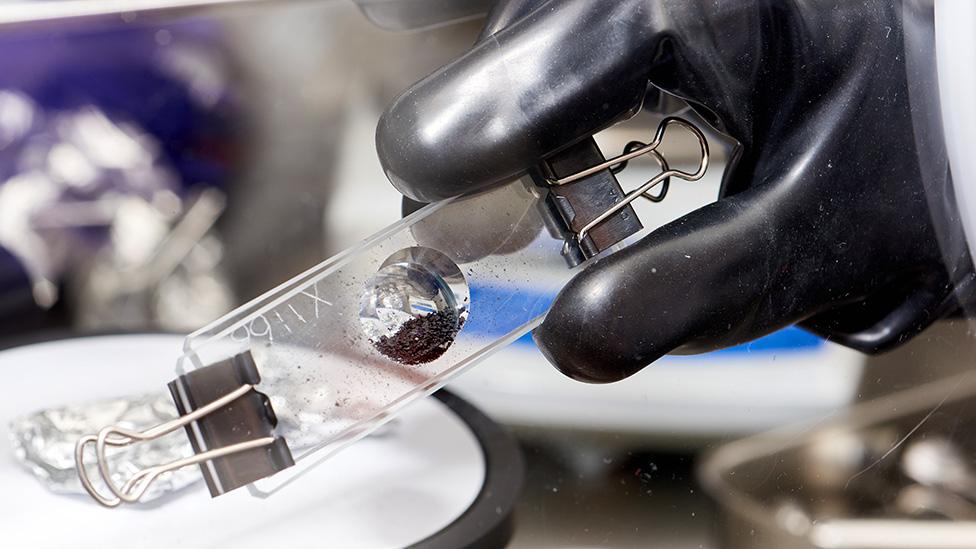Asteroid Bennu: Tiny pieces of rock and dust sent to UK for analysis
- Published
- comments

Fragments from an asteroid described by Nasa as the most dangerous rock in the Solar System are being studied in the UK.
The tiny pieces of rock and dust from the object known as Bennu are being tested at the Natural History Museum, and the Open University in Manchester and Oxford.
Professor Sara Russell, from the Natural History Museum, described the tiny fragments sent to the museum from Nasa as "one hundred milligrams of beautiful".
How did they get the sample of asteroid Bennu?
In 2016, an un-crewed Nasa spacecraft called Osiris-Rex left Earth.
In 2020 the craft completed the first part of its mission, successfully collecting samples from an asteroid called Bennu, 205 million miles away from Earth.
After a seven-year journey, the capsule from Osiris-Rex spacecraft landed safely back on Earth with its very important cargo.
Watch the moment Nasa's Osiris-Rex capsule lands back on Earth
Asteroids are big chunks of rock which float though space and orbit the Sun.
They are much smaller than planets, and can vary in size.
There are lots of asteroids in our solar system, and most of them are in the main asteroid belt, which floats between Mars and Jupiter.
The samples scooped up from the surface of the 500m-wide asteroid are of particular interest to scientists.
US space agency Nasa has described the asteroid as the most dangerous rock in the Solar System because it has a very small chance of hitting Earth in the next 300 years.
Because the surface of the asteroid has hardly changed over time studying rock from its surface could give experts vital information about the formation of our Solar System 4.6 billion years ago.
What could asteroid Bennu tell us about Earth and the Solar System?
Hundreds of scientists around the world are analysing the space rock, including the Diamond Light Source science facility in Harwell, Oxfordshire.
The facility, which is the size of a football stadium, produces brilliant beams of X-rays to help study the fragments of rock in great detail.
Early analysis by Nasa showed the dark black fragments of rock found on Benuu are full of carbon and water-rich minerals.
It's thought asteroids similar to Bennu may have been involved in delivering key materials to Earth and other planets during their early beginnings.
It's potentially how we got the water in our oceans and some of the essential ingredients that were necessary to kick-start life.
When will we find out more about asteroid Bennu?
Scientists in Britain and across the world hope to report on their early work at the Lunar and Planetary Science Conference (LPSC) in March next year.
This fragment, little more than 1mm across, is packed full of information waiting to be extracted
The 100mg given to the UK doesn't sound a lot. If you look at your school ruler and consider that the largest fragments received by the UK are less than 2mm wide and some of the smallest are barely visible to the naked eye, there is a lot to study even on a small scale.
"It's only a teaspoonfull, but if you imagine a teaspoon of sugar and how many individual grains there are in that - we are going to be looking at this material grain by grain," said Prof Russell, from the Natural History Museum.
"It could be a lifetime of work ahead of us."
When the sample canister was opened, a black dust coated all surfaces
Nasa still has more fragments of the space rock that hasn't been studied yet.
But that's partly because the space agency still hasn't yet been able to open fully the Osiris-Rex sample container which is stuck shut. A Nasa team at the Johnson Space Center in Texas is having to get new tools to get it open.
Nasa plans to put most of the Bennu sample straight into the archive to preserve for future generations - for scientists who may not even have been born yet, to work in laboratories that haven't been built, using instrumentation that still hasn't been invented yet.
If you can't see the interactive content on the page, click here.
What do you think of this space news? Let us know in the comments.
- Published12 October 2023
- Published25 September 2023
